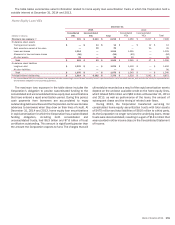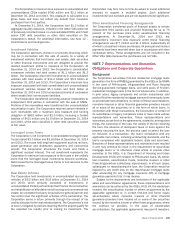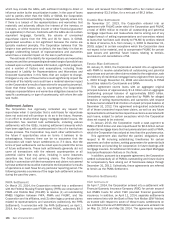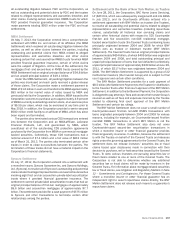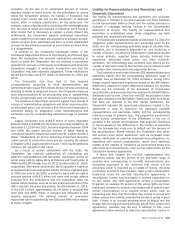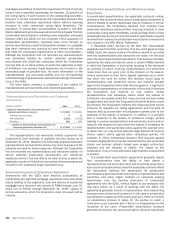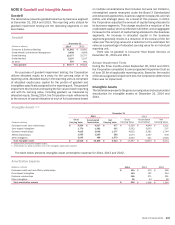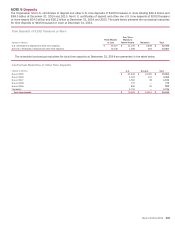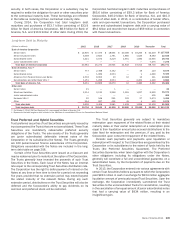Bank of America 2014 Annual Report Download - page 203
Download and view the complete annual report
Please find page 203 of the 2014 Bank of America annual report below. You can navigate through the pages in the report by either clicking on the pages listed below, or by using the keyword search tool below to find specific information within the annual report.Bank of America 2014 201
of loans directly or the right to access loan files directly. For more
information on repurchase demands, see Unresolved Repurchase
Claims in this Note.
Certain whole-loan investors have engaged with the
Corporation in a consistent repurchase process and the
Corporation has used that and other experience to record a liability
related to existing and future claims from such counterparties.
The BNY Mellon Settlement and subsequent activity with certain
counterparties led to the determination that the Corporation had
sufficient experience to record a liability related to its exposure
on certain private-label securitizations, including certain private-
label securitizations sponsored by third-party whole-loan investors,
however, it did not provide sufficient experience to record a liability
related to other private-label securitizations sponsored by third-
party whole-loan investors. As it relates to the other private-label
securitizations sponsored by third-party whole-loan investors and
certain other whole-loan sales, as well as certain private-label
securitizations impacted by recent court rulings on the statute of
limitations, it is not possible to determine whether a loss has
occurred or is probable and, therefore, no representations and
warranties liability has been recorded in connection with these
transactions. The Corporation’s estimated range of possible loss
related to representations and warranties exposures as of
December 31, 2014 included possible losses related to these
whole-loan sales and private-label securitizations.
The majority of the repurchase claims that the Corporation has
received and resolved outside of those from the GSEs and
monolines are from third-party whole-loan investors. The
Corporation provided representations and warranties in
connection with the sale of whole loans and the whole-loan
investors may retain the right to make repurchase claims even
when the loans were aggregated with other collateral into private-
label securitizations sponsored by the whole-loan investors; in
other third-party securitizations, the whole-loan investor’s rights to
enforce the representations and warranties were transferred to
the securitization trustees. The Corporation reviews properly
presented repurchase claims for these whole loans on a loan-by-
loan basis. If, after the Corporation’s review, it does not believe a
claim is valid, it will deny the claim and generally indicate a reason
for the denial. When the whole-loan investor agrees with the
Corporation’s denial of the claim, the whole-loan investor may
rescind the claim. When there is disagreement as to the resolution
of the claim, meaningful dialogue and negotiation between the
parties are generally necessary to reach a resolution on an
individual claim. Generally, a whole-loan investor is engaged in the
repurchase process and the Corporation and the whole-loan
investor reach resolution, either through loan-by-loan negotiation
or at times, through a bulk settlement. Although the timeline for
resolution varies, if the Corporation agrees that there is a breach
that meets contractual requirements for repurchase, the claim is
generally resolved promptly. When a claim has been denied and
the Corporation does not hear from the counterparty for six
months, the Corporation views these claims as inactive; however,
they remain in the outstanding claims balance until resolution.
At December 31, 2014, for loans originated between 2004 and
2008, the notional amount of unresolved repurchase claims
submitted by private-label securitization trustees, whole-loan
investors, including third-party securitization sponsors, and others
was $24.5 billion, including $3.2 billion of duplicate claims
primarily submitted without a loan file review. These repurchase
claims include claims in the amount of $4.7 billion, net of duplicate
claims, where the Corporation believes the statute of limitations
has expired under current law. The Corporation has performed an
initial review with respect to substantially all of these claims and
although the Corporation does not believe a valid basis for
repurchase has been established by the claimant, it considers
claims activity in the computation of its liability for representations
and warranties.
Monoline Insurers Experience
During 2014, the Corporation had limited loan-level
representations and warranties repurchase claims experience with
the monoline insurers due to settlements with several monoline
insurers and ongoing litigation with a single monoline insurer. To
the extent the Corporation received repurchase claims from the
monolines that were properly presented, it generally reviewed them
on a loan-by-loan basis. Where the Corporation agrees that there
has been a breach of representations and warranties given by the
Corporation or subsidiaries or legacy companies that meets
contractual requirements for repurchase, settlement is generally
reached as to that loan within 60 to 90 days. For more information
related to the monolines, see Note 12 – Commitments and
Contingencies.
Open Mortgage Insurance Rescission Notices
In addition to repurchase claims, the Corporation receives notices
from mortgage insurance companies of claim denials,
cancellations or coverage rescission (collectively, MI rescission
notices).
For loans sold to the GSEs or private-label securitization trusts
(including those wrapped by the monoline insurers), MI rescission
notices may give rise to a claim for breach of representations and
warranties, depending on the terms of governing contracts. If the
governing contract requires the Corporation to repurchase the
affected loan or indemnify the investor for the related loss due to
MI rescissions, the Corporation may realize the loss without the
benefit of MI. In addition, mortgage insurance companies have in
some cases asserted the ability to curtail MI payments as a result
of alleged foreclosure delays thus reducing the MI proceeds
available to offset the loss on the loan.
In certain settlements with the GSEs, the Corporation has
generally agreed to pay the amount of MI coverage to the GSEs
for loans that are the subject of MI rescission notices. Depending
on the terms of settlement agreements or lack thereof with the
mortgage insurance companies, the Corporation may collect only
a portion of the amounts paid to the GSEs from the mortgage
insurance companies.
The Corporation had approximately 65,000 open MI rescission
notices at December 31, 2014 compared to 101,000 at
December 31, 2013. The decline results primarily from
settlements with certain MI companies that have been approved
by the GSEs. Open MI rescission notices at December 31, 2014
included approximately 17,000 pertaining principally to first-lien
mortgages sold to the GSEs and other investors as well as loans
held-for-investment. At December 31, 2014, the Corporation also
had approximately 48,000 open MI rescission notices pertaining
to second-lien mortgages which are implicated in ongoing litigation
with a mortgage insurance company where no loan-level review is
currently contemplated nor required to preserve the Corporation’s
legal rights. In this litigation, the litigating mortgage insurance
company is also seeking bulk rescission of certain policies,
separate and apart from loan-by-loan denials or rescissions.


